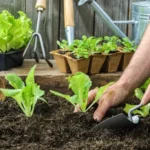A leaking garden tap can waste water and drive up your bills without you even noticing. Fixing it yourself saves money and prevents further damage to your outdoor plumbing. You don’t need to be a professional plumber to tackle this common issue.
With a few simple tools and some basic know-how, you can stop that drip and keep your garden running smoothly. Whether it’s a worn washer or a loose connection, understanding the cause is the first step to a quick fix. Let’s walk through the easy steps to get your garden tap leak-free in no time.
Common Causes of a Leaking Garden Tap
Identifying the cause of a leaking garden tap simplifies the repair process. Pinpointing these issues helps you choose the right fix and prevent future leaks.
Worn Out Washers and O-Rings
Worn out washers and O-rings cause most garden tap leaks. Washers seal the tap when closed and O-rings prevent water from escaping around the handle. Over time, rubber washers and O-rings become brittle or cracked, allowing water to drip. Replacing these parts restores a proper seal and stops the leak efficiently.
Corroded Valve Seat
A corroded valve seat often causes leaks inside the tap body. Dirt and minerals build up at the valve seat, creating an uneven surface that prevents the washer from sealing correctly. Cleaning or replacing the valve seat restores smooth contact and stops water from leaking through when the tap is off.
Loose or Damaged Connections
Loose or damaged connections between the tap and pipe allow water to seep out. Threaded fittings may loosen during use or freeze-thaw cycles, while cracks or wear in the tap body cause leaks at connection points. Tightening fittings or replacing damaged parts ensures a secure, watertight connection that stops leaks.
Tools and Materials Needed
Identify the right tools and parts before starting the repair to save time and ensure a smooth fix.
Essential Tools for the Repair
- Adjustable wrench for loosening and tightening fittings
- Screwdrivers, both flathead and Phillips, for removing tap handles
- Pipe wrench for gripping stubborn or rusted connections
- Pliers to hold small components securely
- Utility knife to cut damaged washers or seals
- Wire brush or sandpaper to clean valve seats and remove corrosion
- Bucket or container to catch excess water during disassembly
Recommended Replacement Parts
- New rubber washers in sizes matching your tap model
- Replacement O-rings to seal moving parts effectively
- Valve seat replacement if corrosion or damage exists
- PTFE tape (plumber’s tape) to secure threaded connections and prevent leaks
- Tap grease to lubricate washers and moving parts for smooth operation
Step-by-Step Guide on How to Fix a Leaking Garden Tap
Follow these precise steps to stop water leakage from your garden tap effectively. The process involves turning off the water, inspecting parts for wear, replacing damaged components, and testing the repair.
Turning Off the Water Supply
Locate your main water shut-off valve and turn it off to stop water flow to the garden tap. Drain any remaining water by opening the tap fully. Confirm no water flows before proceeding to avoid water damage.
Disassembling the Tap
Use an adjustable wrench or pliers to remove the tap handle screw and handle. Unscrew the tap body with a pipe wrench to access the internal components. Keep all parts organized to ensure smooth reassembly.
Inspecting and Replacing Washers or Seals
Examine rubber washers and O-rings for cracks, brittleness, or deformities. Remove worn washers using a utility knife or screwdriver. Replace them with exact-size, new rubber washers and O-rings to ensure a tight seal.
Cleaning or Replacing the Valve Seat
Inspect the valve seat inside the tap body for corrosion or mineral buildup. Use a wire brush or sandpaper to clean minor deposits. Replace the valve seat if deep corrosion or damage is evident—this prevents future leaks.
Reassembling and Testing the Tap
Apply tap grease to the new washers and valve seat for smooth operation. Reassemble the tap in reverse order, ensuring all connections are tight and secure. Turn the main water valve back on and open the tap to check for leaks and proper water flow.
Preventive Tips to Avoid Future Leaks
Check your garden tap regularly for signs of wear. Replace washers and O-rings at the first hint of brittleness or cracking, as early replacement prevents leaks. Tighten tap connections periodically to keep joints secure and stop seeping. Clean the valve seat and remove mineral buildup yearly, using a wire brush or sandpaper to maintain a smooth seal. Apply tap grease to washers and O-rings during installation to reduce friction and extend their lifespan. Drain the tap before winter or freezing weather to avoid cracked components caused by frozen water. Insulate outdoor taps with foam covers during cold months to protect against temperature damage. Use high-quality replacement parts, such as durable rubber washers and corrosion-resistant valve seats, to enhance reliability. Monitor water pressure connected to the tap, ensuring it stays within recommended levels to prevent stress on fittings and seals.
Conclusion
Fixing a leaking garden tap is a manageable task that can save you money and protect your outdoor plumbing. With the right tools and a little know-how, you can stop leaks quickly and keep your garden tap working smoothly. Regular maintenance and timely repairs will help you avoid bigger problems down the line. Taking control of this simple fix means you’re preventing water waste and ensuring your outdoor space stays in great shape year-round.

Hi, I’m Md Rofiqul, a gardening enthusiast who loves spending time in the garden and backyard. I enjoy caring for plants, growing flowers and vegetables, and creating a green space that feels peaceful and refreshing. Gardening is more than just a hobby, it’s a passion that connects me to nature and brings joy to my daily life. Living with plants inspires me to embrace simplicity, patience, and sustainability while making every day more colorful and rewarding.

